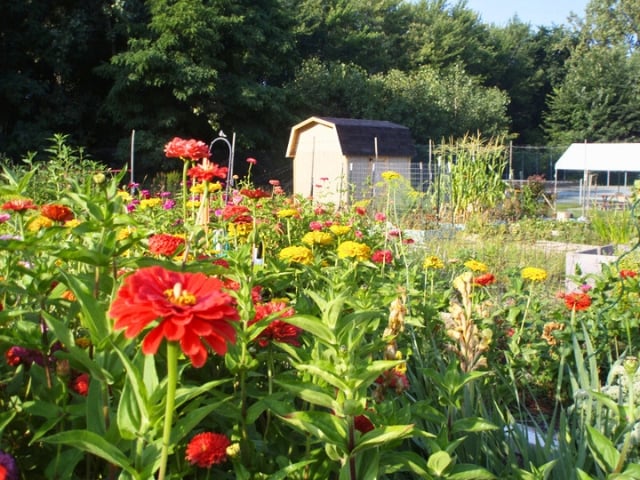Published: March 28, 2024
 Many of us like to dine at restaurants that advertise as being “farm to table” or “farm to fork,” meaning that most or all of the food on the table comes from regional farmers and growers and so is fresher and healthier. During March, National Nutrition Month, the Academy of Nutrition and Dietetics wants consumers to look for ways to bring that cooking concept into their kitchen.“This year's theme is Beyond the Table, which addresses the farm-to-fork aspect of nutrition, from food production and distribution to navigating grocery stores and farmers markets — and even home food safety and storage practices. It also describes the various ways we eat — not only around a dinner table, but also on the go, in schools and restaurants, at games and events. This theme also includes sustainability, for instance, decreasing food waste from school and work to home and beyond,” according to the Academy.
Many of us like to dine at restaurants that advertise as being “farm to table” or “farm to fork,” meaning that most or all of the food on the table comes from regional farmers and growers and so is fresher and healthier. During March, National Nutrition Month, the Academy of Nutrition and Dietetics wants consumers to look for ways to bring that cooking concept into their kitchen.“This year's theme is Beyond the Table, which addresses the farm-to-fork aspect of nutrition, from food production and distribution to navigating grocery stores and farmers markets — and even home food safety and storage practices. It also describes the various ways we eat — not only around a dinner table, but also on the go, in schools and restaurants, at games and events. This theme also includes sustainability, for instance, decreasing food waste from school and work to home and beyond,” according to the Academy.
Here are 5 ideas to bring the local farm to your kitchen table.
- Grow vegetables. You don’t have to have a big patch of land to grow a handful of tomatoes or other vegetables and herbs. You can also bring the garden inside by using grow lights. Or find a nearby community garden. Check the American Community Gardening Association map or contact your local City Hall or parks department.
Growing your own vegetables can save money, and much more. “Our vegetable gardens have the potential to feed us on a soul-deep level. They can serve as the anchoring center point of a life full of rich, satisfying joys – often grown with our own two hands,” writes Megan, the “Creative Vegetable Gardener” blogger. - Eat seasonally. Many grocery stores support local farmers, so if you eat strawberries in April, May and June you are likely to be consuming regional produce.
“Seasonal fruits and vegetables produced on local farms are often fresher, as they do not require long distances for transport. Also, unlike out of season produce which is harvested early in order to be shipped and distributed to your local retail store, crops picked at their peak of ripeness are also better tasting and full of flavor. What’s more, studies have shown that fruits and vegetables contain more nutrients when allowed to ripen naturally on their parent plan,” according to the Seasonal Food Guide, a handy interactive directory of produce harvest times by state.
- Shop at local farm markets. The Oberlin Outdoor Farmers Market opens May 18 and will be open every Saturday 9 a.m. to 12 p.m. through Oct. 12 in the parking lot by the Oberlin Public Library. As the growing season progresses you’ll find many farm stands and markets selling local produce, including Grobe Fruit Farm in Elyria and Quarry Hill Orchards and Burnham Orchards, both in Berlin Heights.
- Eat more plant-based meals. “Eating plant-based does not mean you can’t eat meat. It means your meals are mostly plants: vegetables, whole grains and fruits. Beans, seeds and nuts are also included. Fill two-thirds of your plate with these plant-based foods. The remaining one-third should be a lean protein like chicken or fish, or a plant protein like tofu or beans,” explains MD Anderson Cancer Center.
And use healthy cooking methods. For instance steam vegetables, reduce salt and season with herbs and spices.
The benefits of a plant-based diet are many, including it supports your immune system, reduces inflammation and helps you maintain a healthy weight.
- Make healthy choices at the grocery store. For many families, grocery shopping is a weekly chore so follow these tips from the American Heart Association to make sure you’re making healthy choices:
Plan meals and a shopping list before you head out; Shop the outer perimeter first; read nutrition labels and choose the items with the lowest amounts of sodium, saturated fat and added sugars; when buying grains and bread products look for items that list a whole grain first (such as whole wheat) instead of enriched flour or “multi-grain”; and don’t shop on an empty stomach.
Check Out Our New Gardening Guide:
Gardening is a great activity at all ages. Get helpful tips here!
 In the past, Molly Kavanaugh frequently wrote about Kendal at Oberlin for the Cleveland Plain Dealer, where she was a reporter for 16 years. Now we are happy to have her writing for the Kendal at Oberlin Community.
In the past, Molly Kavanaugh frequently wrote about Kendal at Oberlin for the Cleveland Plain Dealer, where she was a reporter for 16 years. Now we are happy to have her writing for the Kendal at Oberlin Community.
About Kendal at Oberlin: Kendal is a nonprofit life plan community serving older adults in northeast Ohio. Located about one mile from Oberlin College and Conservatory, and about a 40 minute drive from downtown Cleveland, Kendal offers a vibrant resident-led lifestyle with access to music, art and lifelong learning.




